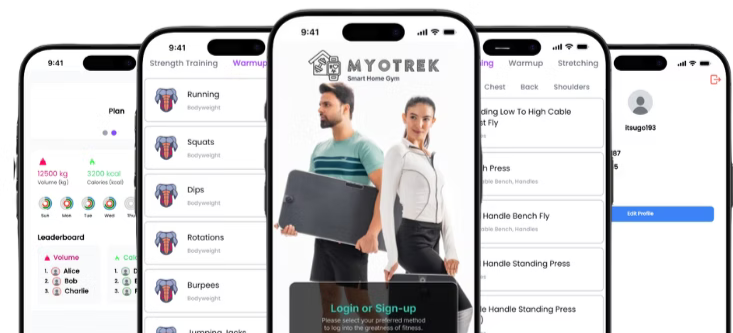
Myotrek — Case Study
A full React Native fitness tracker with personalized workout logging, stats, and smooth navigation.
Built as a freelance project and deployed on both the Play Store and App Store.
Background / Why This Matters
This project came from a client who built a compact home-gym device that uses magnetic resistance to replicate gym-style training.
They needed a mobile app that could:
- guide users through workouts
- show proper form through embedded tutorial videos
- log sets, reps, and volume
- sync progress across devices
It was a practical problem:
a physical product needed a digital companion to make the experience complete.
Project Goal
Build a mobile app that:
- works smoothly on both Android and iOS
- lets users log workouts and track stats
- embeds YouTube tutorials for each exercise
- stores data efficiently without recurring database costs
- ships on time despite tight tooling and device constraints
Since this was a freelance delivery, the app had to feel polished, intuitive, and reliable.
My Role
I handled all frontend engineering:
- React Native (Expo SDK 52)
- Workout screens, logging UI, and stats
- Navigation, layout, and transitions
- Embedded video flows
- Local data structures for workouts
- Coordination with backend (Firebase)
A teammate managed Firebase auth, Firestore, and deployments.
Architecture Overview
Frontend
- React Native + Expo 52
- Custom workout screens with set/rep/volume tracking
- Local library file storing exercises, names, images, and tutorial links
- Robust navigation setup for multi-screen flow
- Visual stats and progress summaries
Backend
- Firebase Authentication
- Firestore for cloud sync
- Expo EAS for builds and updates
Content Storage
To avoid recurring database costs, we shipped a local exercise library inside the app bundle:
- metadata
- images
- tutorial URLs
- categories
It kept the product lightweight and inexpensive to maintain.
How It Works (Flow)
- User opens the app and logs in.
- Chooses a workout category or exercise.
- Tutorial video loads through a YouTube embed.
- User logs sets, reps, volume, or duration.
- Data syncs to Firebase (or is saved locally when offline).
- Stats and charts update automatically.
- Monthly leaderboards show top performers across metrics.
The flow stays consistent across iOS and Android.
Key Challenges & Solutions
1. Tooling and Version Mismatches
Problem:
Expo, React Native, EAS, Play Store, and App Store tooling all demanded different versions and configs.
Builds would fail for reasons that weren’t obvious.
Solution:
We rebuilt the environment using the latest Expo SDK, re-aligned packages, and followed documentation strictly.
Keeping everything on the most recent toolchain turned out to be the most stable approach.
2. Limited Development Hardware
Problem:
My personal laptop struggled during builds, and we had no macOS device initially for iOS deployment.
Solution:
We optimized dev builds with lighter configs and eventually secured a MacBook towards the end of the project specifically for App Store deployment.
That made our final shipping window possible.
3. No Budget for Full Exercise Database
Problem:
The client didn’t want recurring costs for storing exercise metadata.
Solution:
We embedded a local JSON-style library containing all workout definitions, images, and links.
This kept the app lightweight, predictable, and free to maintain.
Outcomes / Learnings
The app has been live for more than six months, with consistent usage and no production-breaking issues.
Delivering on both stores taught me:
- store deployments require strict version discipline
- Expo + EAS can handle full production pipelines
- local libraries are a solid solution for early-stage products
- cross-platform video embedding needs careful testing
- reliable UX is more about predictability than complexity
This project was a strong, real-world exercise in end-to-end mobile delivery.
Final Thoughts
Myotrek showed me what a complete mobile product cycle looks like: planning, building, aligning tools, shipping, and maintaining.
It wasn’t the largest project, but it demanded discipline with versions, builds, and cross-platform consistency — exactly the challenges that make mobile work interesting.